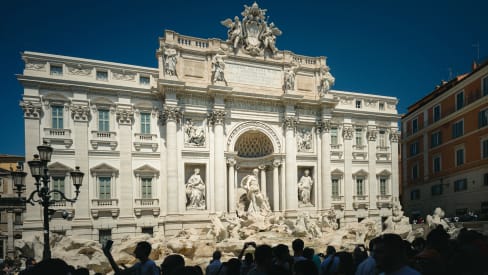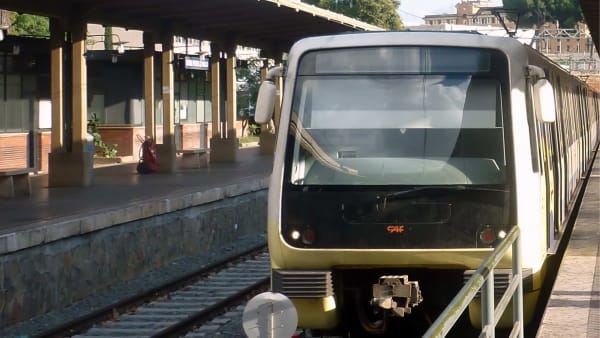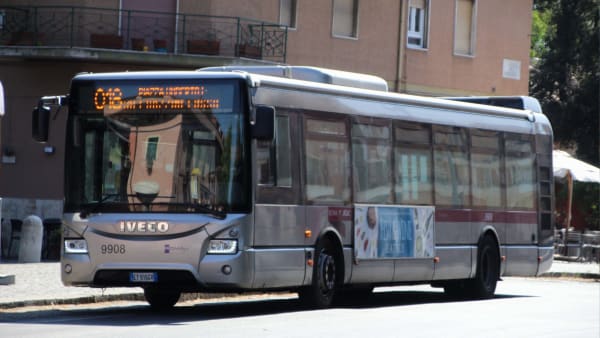Brief history
Brief history
The wonderful waterwork has multiple symbolic connections to mythology as the fountain has a long history. Although it took more than 100 years to create the current artwork, its history began more than 2,000 years ago.
Imperial period (27 BC - 476 AD)
According to legend, in 19 BC, a few miles outside of Rome, a new water source was discovered by a young virgin. Shortly after she showed Roman soldiers the way to the spring, the aqueduct Aqua Virgo (virgin water) was built primarily to supply water to the Baths of Agrippa in the Campus Martius.
The aqueduct was built under the guidance of architect Marcus Vipsanius Agrippa (known from the Pantheon) and eventually became one of eleven aqueducts that supplied water to ancient Rome. The Aqua Virgo runs mostly underground, is nearly twenty kilometers long, and is one of three aqueducts from ancient times that are still active today.
The aqueduct has been restored many times and is known today as Acqua Vergine, the source of the Trevi Fountain and the Fontana della Barcaccia near the Spanish Steps, among others. Where the endpoint of the aqueduct used to be, now the majestic Trevi Fountain is situated. However, it only consisted of three basins in which water was stored for the population during this period.
Middle Ages (476 - 1492)
It retained this form until 1453 when Pope Nicholas V commissioned the redesign to Leon Battista Alberti. The three basins were replaced by one large basin from which the Romans could draw water.
Despite the damage caused by the First Siege of Rome in the Gothic War in 537, the work was used throughout the Middle Ages. However, the first graphic documentation dates back to 1410, when a fountain was built with three mouths pouring water into three separate basins side by side, in the middle of an intersection (trevio) on the east side of Quirinal Hill.
Renaissance (1492 - 1789)
In 1640, Pope Urban VIII commissioned the architect and sculptor Gian Lorenzo Bernini to make significant changes to the work. The project envisioned a new scenographic panorama to be seen from the Quirinal Palace, the Pope’s summer residence.
Bernini embarked on the project without the required permit, financed by tax money from the Roman population. The original idea was to build two large concentric semicircular basins and place a pedestal in the middle that would probably serve as a base for a statue of the Virgin Trivia.
Instead, the money was used for the war the pope declared on the Duchy of Parma and Piacenza, and the work was interrupted. After the death of Urban VIII and the arrival of Pope Innocent X, the fountain fell into disrepair.
Nearly sixty years passed before Clement XI re-engaged with the work of the Trevi Fountain. Such delays were common in major works by Italian and foreign architects throughout the history of the Italian peninsula.
In 1731, Clement XII organized a design competition that was eventually won by Nicola Salvi. He decided to tell the story of the Acqua Vergine by creating a union between architecture and sculpture. He had taken this idea from the original plan by Pope Urban VIII and Bernini. It’s said that Salvi’s project was also chosen because it was cheaper than the others.
The work was financed by the reintroduction of the lottery in Rome. Construction of the fountain began in 1732 but was repeatedly interrupted due to both lacks of money and artistic disagreements between Salvi and sculptor Giovanni Battista Maini. In the end, neither Salvi, the pope, nor his successor Benedict XIV saw the completion of the work.
During the pontificate of Pope Clement XIII, the work wasn’t completed until 1762 by the sculptor Pietro Bracci. On the evening of May 22, 1762, after thirty years of work, it was finally shown to the public in all its grandeur.
Contemporary period (1789 - present)
In recent years, the fountain has undergone various maintenance and restoration interventions. In 1998, for example, the fountain was thoroughly cleaned. And in 2014, it took seventeen months to restore the work, which cost the Italian fashion brand Fendi 2.2 million euros.
During this period, a temporary panoramic bridge was located over the basin so that visitors could admire the fountain and the restoration work up close.
The reinauguration ceremony of the Trevi Fountain took place on November 3, 2015. Hundreds of people attended the reopening of the Aqueduct pipes that filled the basin. Finally, in 2019, Mayor Virginia Raggi presented a plan to renew the artistic lighting.















